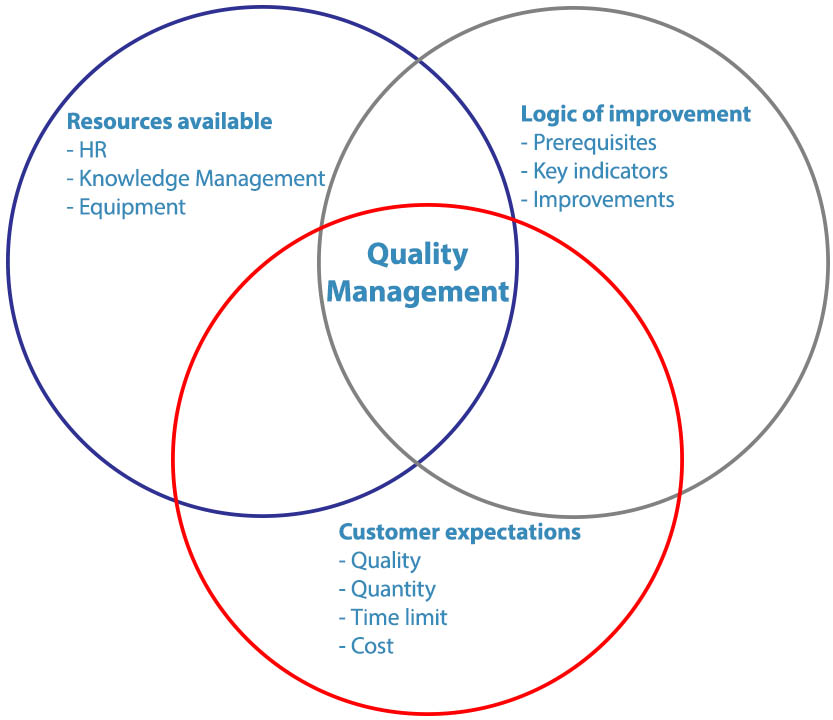

"The quality initiative is a project implemented in order to control, ensure, plan and improve products and services, as well as for client satisfaction."
Summary:
It is essential to have a quality initiative in order to be able to offer quality products and services to your clients in the fashion world and, more particularly, in the leather goods, textiles, gloves and shoes sector. We describe below what such a quality policy and initiative involve and their advantages for this sector.
The quality initiative is a project implemented in order to control, ensure, plan and improve products and services, as well as for client satisfaction.
On a larger scale, therefore, the quality policy can lead to an improvement in performance and satisfaction for all those involved in the various stages of production, whether this relates to leather goods, shoes, gloves or fashion, whether this be in textiles, polymer or leather.

Leather fashion and textile quality initiative
In the fashion world, this means ensuring that each stage of manufacture fulfils the previously established conditions so that the end product is of high quality and in accordance with consumers’ expectations, whatever the sector concerned.
The quality initiative also implies a phase of evaluation of the product and/or of the action taken in order to be able to evolve the offer and to enable better decision-making. It is the responsibility of the company involved to carry out the evaluation in order to measure the distance existing between the objectives it has fixed and those realised during production. Carrying out a quality initiative therefore means reducing these discrepancies. This evaluation is carried out upstream in the form of checking the quality references and either current or downstream auditing in the form of inspections , physical , chemical tests and leather tests.
CTC can help you with these various evaluation phases.
Please contact us for further information.
According to standard NF X 50-120 (1987) ISO 8402, “product quality” is defined as:
“All the properties and characteristics of a product which demonstrate its ability to meet the expressed or implicit requirements of the user”.
Definition of client satisfaction according to the ISO: International Organisation for Standardisation.
According to standard ISO 9000:2005, client satisfaction is defined as:
“The client’s perception of the level of satisfaction of his requirements”.
Client satisfaction is one of the principal aims of quality, as well as the satisfaction of the regulatory demands and company profitability.
For this, the product must respond to specifications, requirements and expectations.
So, it is necessary to define “quality requirements”.
Generally, in order to implement a quality initiative, a company draws up in advance a quality policy determining the objectives of production and/or services, as well as management. This quality policy is then approved and incorporated.
For companies in the “leather fashion” sector, this is a real asset which should be showcased.
Indeed, end-consumers will appreciate knowing that the manufacture stages of the products are reputable, environmentally-friendly and healthy from the safety point of view.
Economic aspect of quality: a mass market example.
Source: Book “Company management 360°” - Chapter 4: Management through quality.
Thomas Durand – CNAM Lecturer – Publication September 2016:
“50% of the people questioned declared having had problems with products,
21% of unhappy consumers and who do not correspond abandon the brand,
only 3% of those who abandon the brand write to the company.
1 letter = 5,830 unhappy consumers
and 1,230 consumers who abandon the brand = around 6 tonnes lost”.
According to the first “Observatoire du sens” [Meaning monitor], an enquiry carried out among a sample of 1,004 people by the Wellcom agency with the ViaVoice Institute:
“6 out of 10 French people expect a brand to have meaning.
Meaning revolves around 4 essential values:
As far as brands and companies are concerned, the leading trio are:
64% of French people would be ready to leave a brand following a bad client experience”.
Source: http://www.qualiteperformance.org
“Quality is not only a matter of good sense, tools and techniques. It is a state of mind, an initiative for change and a method involving all company players. It requires collective awareness and a permanently-evolving internal company culture”.
“The quality initiative rests on fundamental principles:

Quality policy management
The quality initiative can be divided into four stages:
This involves evaluating its attributes and the means of improvement, which can be measured using the distance between objectives and practice.
This implies an examination of:
After having established the definition of its objectives, observations need to be made and finally its advantages and weak points need to be recognised and expressed articulately. It is at this point that the action plan is drawn up.
According to the previous observations, some movement towards improvement must be made. This is organised thematically and in priority order. The latter varies according to the importance of the relationship between the improvement axis and feedback from clients, as well as the ability of the department to implement this improvement.
A company manufacturing shoes, leather goods, gloves, leather and fashion textiles must ensure its sourcing is secure. It is essential to be able to call on certified suppliers in order to benefit from quality raw materials and products in line with your production criteria. Several possibilities can be envisaged in this domain.
Firstly, it is important to implement audits and inspections. These respond to various challenges:
Within the framework of the quality initiative for leather products, some requirements need to be defined depending on usage in the various production stages. In particular, this means adapting the quality processes with specific inspection plans.
Then, depending on the production stage, design control should be carried out using a chemical test and/or a physical test (on samples and prototypes) and another before boarding (on the finished product) and finally a quality control on reception. In addition, it is necessary to carry out inspections, depending on the product risk or supplier risk. It will also be important to implement some “quality” charters. You may also consider introducing a defects library to which you can refer. Finally, you can also opt to carry out end-of-season assessments (relating to products, suppliers etc.) which will allow you to have an on-going improvement drive.

The implementation of the action plan must respond to the regulatory requirements. These requirements relate to health and personal safety.
According to French Law No. 93.949 (26/07/93). Article L.221-1 of the Consumer Code,
General Directive on Product Safety,
Products and services must, under normal conditions of use or in other conditions reasonably foreseeable by the professional, present the safety that can legitimately be expected and not harm the health of persons.
The delivered articles must respect all the requirements applicable to the product:
French Law No. 94.665 (04/08/94) relating to the use of the French language,
European Directive 94/62/CE + Directive 2004/12/EC - French Decree No. 98-638 of 20/07/1998,
Directive relating to all types of packaging,
Aim: to reduce heavy metals and favour the recycling and re-use of packaging materials.
European Regulation 519/2012 of 19/06/12 amending European Regulation 850/2004 relating to Persistent Organic Pollutants (POPs):
Aim: to monitor, reduce and eliminate the emissions from these substances into the environment.
Aim: Reduce the use of dangerous substances and protect human and environmental health.
Substances concerned:
NB:
Legal responsibility: Conservation of information on the substances present in our products in order to be able to respond to any client request over the course of 10 years.
For SVHC, the person responsible for placing the product on the market has 45 days to respond to clients in the event of a request.
Management of client feedback:
=> Brand-specific requirements and test conditions.
The legislative text states:
From the time they are first put on the market, products must respond to the provisions in force relating to the safety and health of persons, to the loyalty of commercial transactions and consumer protection.
The person responsible for first putting a product on the market is therefore required to check that this is in compliance with the provisions in force.
At the request of authorised officers, he is required to justify the checks and inspections carried out.
Professional are required to retain the documents certifying that self-monitoring operations have truly been carried out and must produce them, where appropriate, at the request of the authorities mentioned in Article L.215-1 operating within the framework of their monitoring function.
Note: There are no specific sanctions for professionals’ failure to observe their self-monitoring obligation.
There are consequences for the failure to respect this preventive measure - the fact of putting a non-compliant product or service on the market - which are sanctioned by the provisions foreseen in Articles L.213-1 and following.
Having recourse to certification allows a quality initiative to be pursued. It adds value to the quality initiative implemented and proves the company’s commitment to it. The certification helps to validate the progress obtained, as well as the goals reached, while remaining coherent with the sector references. In the same way, it also shows the resolution to improve in an on-going way.
It should be recalled that European regulation 1007/2011 relating to textile names states that the products concerned and named as textiles must contain at least 80% of their weight in textile. Another French decree (2010-29 of 8th January 2010) relating to some leather and similar products states that there is no notion of minimal percentage weight. And, for mixed products, reference must be made to one of these two regulations on a case-by-case basis.
Certification implies a financial commitment which will depend on the difference between the practice of the company concerned and the requirements present in the frame of reference and also the size of the activity concerned.
Having been certified, the company acquires the right to use a mark recognised by clients. In other words, this mark becomes a reinforcement of its brand image.
Certification then establishes timelines to ensure the impetus of the initiative through regular audits, the monitoring of documentation, diagnostic tests etc. In addition, the certifying body can bring a different and innovative point of view which can lead to improvements in the stages of production.
It is the job of the pilot, generally the quality manager, to quantify the improvements, as well as their enhancement and the correction of errors.
Examining the mobilisation of resources, the carrying out of activities, the effects produced and the effects observed allows any potential derivation from the action plan to be identified. This can also lead to the evolution of the action plan and the contents of the action sheets. These observations must be founded on objective and proven data. These developments show the capacity for adaptation and progress.
In order for a quality initiative to be of benefit to a company, it is necessary for it to be understandable and for all staff to be sufficiently trained in the tasks required of them. The nomination of a quality representative for the sales, technical and production departments will be necessary. As far as large companies are concerned, a quality department should be created.
In all cases, transparent communication regarding the expected objectives and the quality process with the various stakeholders in the chain is a guarantee of success and participation.
The advantages of the quality initiative lead to client satisfaction. Indeed, relationships of trust will be strengthened and clients will be retained.
You will observe an optimisation of resources, whether financial, material or human, without forgetting that you will be participating in the strengthening of your credibility within your country: your brand image can only be strengthened.
Consequently, the quality initiative is a means of bolstering your company, dynamizing your activity and fulfilling both client demands and those of the regulations.